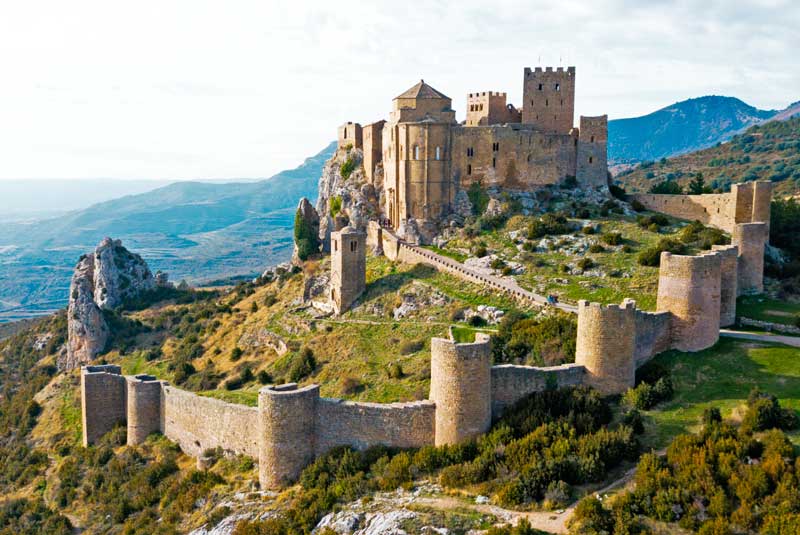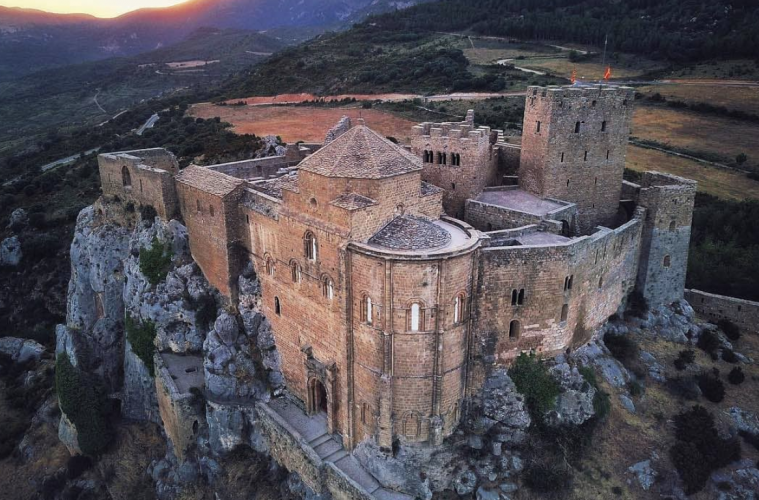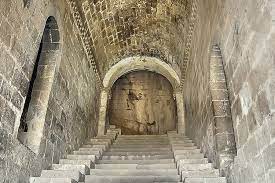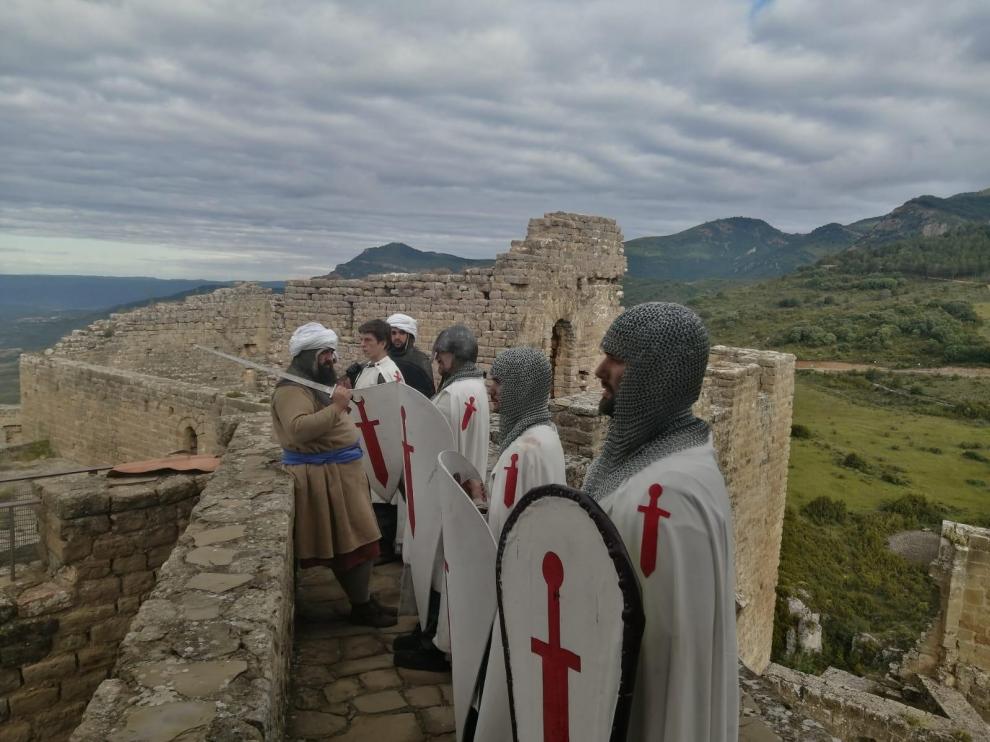
In Huesca, on a very big rock, the castle of Loarre has resisted the passage of time for a thousand years. It is one of the best-preserved medieval castles in Aragon and, furthermore, it can boast of being one of the best-preserved Romanesque fortresses in Europe. It has been a castle, a fortress, a royal residence, a monastery and even a movie set, so it could tell us stories of kings, clergymen, nobles and movie stars.
At 1,070 meters high, it has a fantastic panoramic view over the Hoya de Huesca region. It is a watch-post castle although it lost its military character a long time ago as the Reconquest progressed. Its good state of conservation allows us to imagine what life would have been like within its walls, taking us to another time thanks to its particular beauty. In fact, according to a macro-survey carried out by the Lonely Planet travel guide in which more than 60,000 travellers participated, Loarre Castle has been recognised as the most beautiful castle in Spain, even ahead of the Alcázar of Segovia, the Castle of Cardona, in Barcelona, and Butrón, in Vizcaya.
Loarre Castle can tell us about ten centuries of history. It began as a royal palace, later it became a monastery and, currently, it is one of the most striking tourist attractions in Huesca.

To understand its evolution, we must go back to its beginnings, when in the year 1020 King Sancho III "El Mayor" of Pamplona decided to build it at the gates of the Pyrenees to turn it into a defensive bulwark against the Muslim power. The central nucleus of the castle belongs to this period. A religious component was added with the founding of the monastery of San Agustín towards the year 1071 this involved adding buildings to the initial construction. On the death of the monarch, his son Pedro I built Montearagón as head of the congregation, because of this, Loarre was left without its monastic essence. During the 12th century, the crown fell into oblivion and from this moment on it passed into the hands of different nobles. In the 13th century, it was entrusted to the Order of St John and in the 16th century its inhabitants moved to lower lands and the castle was effectively abandoned.
In 1906 Loarre Castle was declared a National Monument, today it is also classified as an Asset of Cultural Interest, in 1913 it received a restoration that helped to preserve its integrity and between 1996 and 2009 important maintenance works were also carried out, allowing it to shine today in all its glory and, without a doubt, proud of the fact that it is one of the most beautiful medieval castles in Spain.
The castle wall dates from the 13th century and surrounds the entire enclosure, except where the rock acts as a natural defence. Its perimeter is 172 meters and it is defended by circular towers and a rectangular one. Once inside the castle, the first thing that catches your attention is not the construction itself, but the views over the plain of La Hoya de Huesca. Only then do you fully understand the reason for its location.
 After leaving behind the old Albarran tower that belongs to the monastic extension and which at the end of the XI century served as the watchtower over the horizon, we reach the main door that gives us access to the military compound through a staircase covered by a vault. As we go up, to our right is the crypt of Santa Quiteria, a small space for worship and burials with access to the church. The church of San Pedro, from the end of the 11th century, is the space that best tells the story of the old monastery and maintains its Romanesque style in all its splendour. Inside you will undoubtedly notice that the columns are decorated with fantastic figures, plants and scenes from the bible.
After leaving behind the old Albarran tower that belongs to the monastic extension and which at the end of the XI century served as the watchtower over the horizon, we reach the main door that gives us access to the military compound through a staircase covered by a vault. As we go up, to our right is the crypt of Santa Quiteria, a small space for worship and burials with access to the church. The church of San Pedro, from the end of the 11th century, is the space that best tells the story of the old monastery and maintains its Romanesque style in all its splendour. Inside you will undoubtedly notice that the columns are decorated with fantastic figures, plants and scenes from the bible.


From the church, you can continue on to the monastery pavilions where there were first monks and then noblemen. Like any good castle, there is no shortage of dungeons or weapons rooms either. And finally, we come to the door of the old castle, that of Sancho III El Mayor going back to the 11th century. This will lead to the weapons courtyard where we can visit the church of Santa María, the Mirador de la Reina and the wells, with a capacity for 80,000 litres of water. And finally, you will reach the Torre del Homenaje, the highest point of the castle which is 22 meters high and the one of the most difficult to access, constructed with five floors and designed to be a refuge in case of a siege as it is connected to the castle only by a drawbridge and designed to be impenetrable.

If you visit the castle of Loarre keep in mind that today, and due to sanitary restrictions, it is only open on weekends and national holidays. But it is planned that as of June 1, 2021, it will reopen its doors daily and the numerous complimentary activities that entertain the little ones will start again.
If you want more information check out the castle website
http://castillodeloarre.es/en/